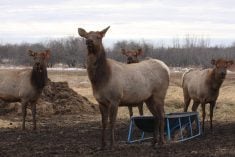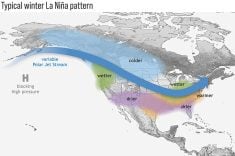Meadow fescue, a long forgotten forage crop, is beginning to make a comeback in North America.
In the 1800s and for the first few decades of the 1900s, meadow fescue was a popular pasture grass in America.
But that popularity came to an end in 1943 when Kentucky 31, a tall fescue variety, was introduced to the marketplace, said Michael Casler, a plant geneticist with the U.S. Department of Agriculture.
“(Kentucky 31) was one those things that was the greatest thing since sliced bread… and (it pushed) meadow fescue just completely from the marketplace,” said Casler, who works at the U.S. Dairy Forage Research Centre in Madison, Wisconsin.
Read Also

Canadian Food Inspection Agency extends chronic wasting disease control program consultation deadline
Date extended for consultation period of changes to CWD program
Meadow fescue was already in trouble before the introduction of Kentucky 31 because field trials showed that tall fescue produced higher yields.
“Everybody (was) like, why do we want this lower growing, lower yielding cousin?” Casler said.
By 1951, demand for meadow fescue was so minimal that production of its seed came to an end in the U.S. and the species was shoved entirely out of the picture.
“It came very close to becoming extinct in North America,” said Casler. “It completely fell away from our consciousness.”
But in the last few years, meadow fescue is making a comeback thanks to Casler and work by the Dutch seed company, Barenbrug.
Recent research has shown that meadow fescue is easily digested, highly palatable and is a tremendous source of energy for cattle.
“We tend to think of perennial ryegrass as being the highest quality of all the grasses,” said Casler.
“Our data actually suggests that meadow fescue is pretty close to perennial ryegrass… I’d rank it (meadow fescue) easily within the top tier of the cool season grasses.”
Casler began his research into meadow fescue two decades ago, when he conducted an experiment to test about 100 varieties of grasses on farms in Wisconsin.
“We did an on-farm grazing study and one of the species we chose was meadow fescue,” said Casler, who acquired seven varieties from Europe, where meadow fescue is widely used for grazing.
The trial confirmed Casler’s expectation, as the meadow fescue yielded 10 percent less than tall fescue.
“But the apparent intake was the same. It appeared as though the cattle ate as much meadow fescue as they ate tall fescue, even though the biomass was lower,” he said.
Although Casler and his colleagues didn’t understand it at the time, his subsequent research on the grass explained what was happening.
“What we’ve figured out is that meadow fescue has higher digestibility than tall fescue. It also has higher palatability,” he said.
“The animals much, much prefer the meadow fescue. They’ll eat more of that.”
When the digestibility is higher, the animal gets more energy from the grass, said Devesh Singh, director of research for Barenbrug.
“Grasses provide their energy mostly through their fibre. The more the fibre digestibility, the higher the energy,” he said.
Singh, who mentioned meadow fescue during his presentation at the Manitoba Grazing School in Brandon this December, noted the grass has great potential to prepare cattle for market.
“So many of the people are using grasses to finish their beef,” he said, noting that a high energy grass like meadow fescue helps cattle put on weight.
Barenbrug’s variety of meadow fescue, Pradel, is now for sale in the U.S. and is on the registration list in Canada, Singh said.
Although it will never replace wheat grasses and bromes in Western Canada, Singh noted that meadow fescue provides a nice complement to those staple grasses.
Barenbrug’s test plots in northern Minnesota indicate that meadow fescue has a better tolerance for cold than tall fescue and produces a similar yield.
The seed company is developing other varieties of the grass, Singh said, including types with a higher yield.
So far, meadow fescue has been tested in cooler, wetter conditions where it is well adapted, Casler said.
“It has pretty good drought tolerance already, but not exceptional drought tolerance.”
Once a sufficient stock of seed is built up, Casler intends to conduct more trials to test meadow fescue’s ability to thrive in other conditions.
How to differentiate meadow fescue from closely related grasses:
- Meadow fescue has no hair on the auricles (appendages at the base of leaf blades) or on the margins of the collar. Tall fescue has hair visible on new leaves.
- Meadow fescue has shorter ligules (structure at the inner junction of the leaf sheath and blade) and rough edges on the leaf blades compared to Italian ryegrass.
- Meadow fescue leaves are rolled in the bud stage.
- Meadow fescue is less coarse, shorter, has narrower leaves, shallower roots and is less persistent than tall fescue.
- Meadow fescue originates from Europe.
- It is closely related to tall fescue, which is predominant in the United States.
- Meadow fescue is also closely related to perennial and annual ryegrass and can be crossed with them.
Source: Alberta Forage Manual















